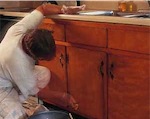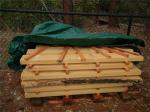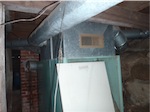About a year ago, I finally did the deed: tackled the partial kitchen remodel that had been a twinkle in my eye for nigh-on 25 years. It was partial because of resource constraints – I didn’t want to spend a ton of money and I also didn’t want to waste a lot of basically sound and serviceable materials.
Foremost among my targets for this retrofit project was the weathered and homely tile countertop – pale avocado, with
However, consistent with my leanings at the time of that earlier blog, I did end up with butcher block. It wasn’t FSC-certified or reclaimed, I am somewhat chagrined to confess – but it met all my other criteria quite nicely: affordable, attractive, reusable (eventually), and durable. It’s birch, 1.5 inches thick, from Ikea; $169 for an 8-foot long by 25-inch wide slab – just $10/square foot.
When the butcher block was first installed, the fellow who cleans our house gave a giant “harrumph” and announced that it was a really stupid choice and would not hold up to the wet environment. I admittedly had my own reservations on this point, but had done my research and was reasonably confident that it would fare well enough. I was willing to accept that it would become somewhat worn and weathered over time; I don’t mind that, particularly for wood. I like the informal, farmhouse look.
One year downstream, I am quite happy with the results, and even the harrumpher has sheepishly acknowledged that his prognostication was incorrect.
That said, I do have some tips about using butcher block.








